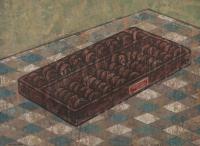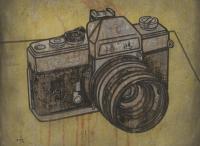THEME: HISTORY
 He Jian is notable for his amalgamation of ancient and contemporary Chinese culture. Rather than painting in oil like most of his contemporaries, he uses rice paper, dry pigment, and binder as his media. He strategically layers and manipulates his paints to take on the timeworn quality of the 14th century Yuan Dynasty frescoes at the Yong Le Temple in Shanxi Province. He Jian uses this distinctive new-old, antiquated style to present a wide range of quotidian subject matter. Although many of his works portray figural groups engaged in activities characteristic of modern Chinese life, in this series He Jian directs his focus towards utilitarian objects that signaled China’s shift towards a consumer culture. The cheap electronics that have dominated Chinese manufacturing in the past two decades have all but obliterated use of the abacus, a traditional Asian counting tool. But it was only as recently as the 1990s when virtually every shopkeeper in the mainland used one. In a short span of time, the abacus has already become a forgotten object, and both He Jian's stylistics and subject matter are informed by this nostalgia.
He Jian is notable for his amalgamation of ancient and contemporary Chinese culture. Rather than painting in oil like most of his contemporaries, he uses rice paper, dry pigment, and binder as his media. He strategically layers and manipulates his paints to take on the timeworn quality of the 14th century Yuan Dynasty frescoes at the Yong Le Temple in Shanxi Province. He Jian uses this distinctive new-old, antiquated style to present a wide range of quotidian subject matter. Although many of his works portray figural groups engaged in activities characteristic of modern Chinese life, in this series He Jian directs his focus towards utilitarian objects that signaled China’s shift towards a consumer culture. The cheap electronics that have dominated Chinese manufacturing in the past two decades have all but obliterated use of the abacus, a traditional Asian counting tool. But it was only as recently as the 1990s when virtually every shopkeeper in the mainland used one. In a short span of time, the abacus has already become a forgotten object, and both He Jian's stylistics and subject matter are informed by this nostalgia.
Click on the artwork for more information-
$35.00
 He Jian is notable for his distinctive amalgamation of ancient and contemporary Chinese culture. Rather than painting in oil like most of his contemporaries, he uses rice paper, dry pigment, and binder as his media. He strategically layers and manipulates his paints to take on the timeworn quality of the 14th century Yuan Dynasty frescoes at the Yong Le Temple in Shanxi Province. He Jian uses this distinctive new-old, antiquated style to present a wide range of quotidian subject matter. Although many of his works portray figural groups engaged in activities characteristic of modern Chinese life, in this series He Jian directs his focus towards utilitarian objects that signaled China’s shift towards a consumer culture. Seagull, the first camera maker in China founded in 1958, released the DF series seen here in 1964, and today, its image instantly conjures nostalgia for the time period. He Jian's painting melds the stylistics of classical China with a subject that heralds its recent history in paintings that negotiate the separate but continuous histories that inform China's present.
He Jian is notable for his distinctive amalgamation of ancient and contemporary Chinese culture. Rather than painting in oil like most of his contemporaries, he uses rice paper, dry pigment, and binder as his media. He strategically layers and manipulates his paints to take on the timeworn quality of the 14th century Yuan Dynasty frescoes at the Yong Le Temple in Shanxi Province. He Jian uses this distinctive new-old, antiquated style to present a wide range of quotidian subject matter. Although many of his works portray figural groups engaged in activities characteristic of modern Chinese life, in this series He Jian directs his focus towards utilitarian objects that signaled China’s shift towards a consumer culture. Seagull, the first camera maker in China founded in 1958, released the DF series seen here in 1964, and today, its image instantly conjures nostalgia for the time period. He Jian's painting melds the stylistics of classical China with a subject that heralds its recent history in paintings that negotiate the separate but continuous histories that inform China's present.
Click on the artwork for more information-
$35.00
 Chen Shijun's distinctive painting style mediates between digital and physical images. The Online Encyclopedia series, for example, takes prosaic images found while browsing online as its source material, and then interprets it through through heavy texturing and a nostalgic palette, converting the raw digital image into a final product with an exceptional sense of physicality. Online Encyclopedia: True Facts No. 2 takes as its source a digital photograph of man's 1960s landing on the moon. The photograph bears the watermark of Xinhua, the official news agency of the Chinese government. Chen Shijun highlights the conflict between battling narratives from the United States, responsible for the landing, and Xinhua, responsible for narrating the story to a Chinese audience. The title of the work, True Facts (2) is a question asking what is reality, how is it represented, and who tells it?
Chen Shijun's distinctive painting style mediates between digital and physical images. The Online Encyclopedia series, for example, takes prosaic images found while browsing online as its source material, and then interprets it through through heavy texturing and a nostalgic palette, converting the raw digital image into a final product with an exceptional sense of physicality. Online Encyclopedia: True Facts No. 2 takes as its source a digital photograph of man's 1960s landing on the moon. The photograph bears the watermark of Xinhua, the official news agency of the Chinese government. Chen Shijun highlights the conflict between battling narratives from the United States, responsible for the landing, and Xinhua, responsible for narrating the story to a Chinese audience. The title of the work, True Facts (2) is a question asking what is reality, how is it represented, and who tells it?
Click on the artwork for more information-
$35.00
 Chen Shijun's distinctive painting style mediates between digital and physical images. The Online Encyclopedia series, for example, takes prosaic images found while browsing online as its source material, and then interprets it through through heavy texturing and a nostalgic palette, converting the raw digital image into a final product with an exceptional sense of physicality. Online Encyclopedia: Disaster, takes as its source material a screen capture of an image search result on a Chinese search machine, showing the iconic photograph of the Hindenberg burning in mid-air. The famous photograph has become ubiquitous, popping up in searches for the word “disaster,” and here Chen Shijun gives the photograph a sense of its age by instilling the painting with rich texture and wear.
Chen Shijun's distinctive painting style mediates between digital and physical images. The Online Encyclopedia series, for example, takes prosaic images found while browsing online as its source material, and then interprets it through through heavy texturing and a nostalgic palette, converting the raw digital image into a final product with an exceptional sense of physicality. Online Encyclopedia: Disaster, takes as its source material a screen capture of an image search result on a Chinese search machine, showing the iconic photograph of the Hindenberg burning in mid-air. The famous photograph has become ubiquitous, popping up in searches for the word “disaster,” and here Chen Shijun gives the photograph a sense of its age by instilling the painting with rich texture and wear.
Click on the artwork for more information-
$35.00








